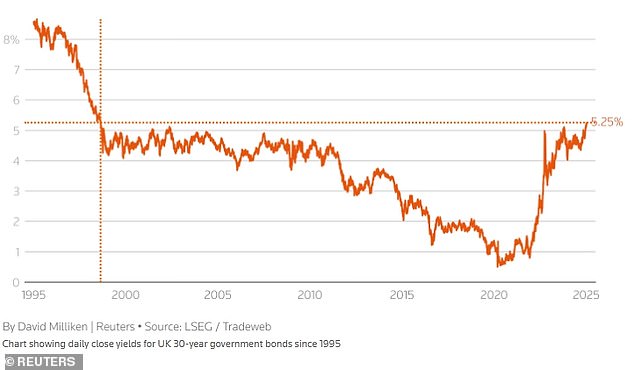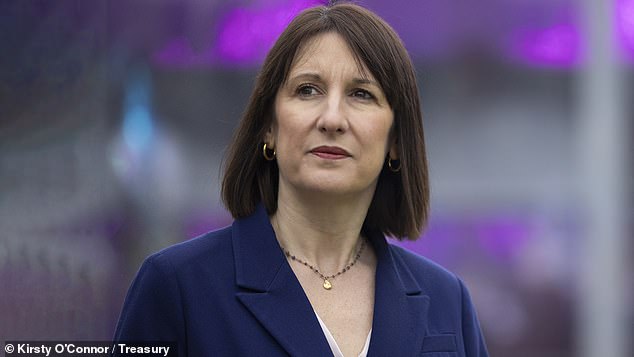Table of Contents
The cost of borrowing soared to its highest level in more than a quarter-century this week as bond yields continue to rise.
Just a few months after the budget, the 30-year bond yield hit over 5.25 per cent on Tuesday, for the first time since 1998, and is above 5.34 per cent today.
Meanwhile, the 10-year bond yield has risen to 4.8 percent, the highest level since the financial crisis.
The yield, which measures how much it costs the government to borrow, is now higher than after Liz Truss’ mini-Budget, raising fears it could raise the cost of borrowing for households and businesses too.
So what are gilts, why are they rising and what does this mean for households and the economy?
What are gilts?
The government generally spends more than it collects in taxes, which means it needs to borrow money.
It can do this by issuing government bonds – known as gilts – which act like IOUs, but the government has to pay interest on the loan.
Under pressure: Rachel Reeves could break her tax rules if bond yields continue to rise
They are considered a relatively safe investment because, like other bonds, the borrower promises to repay the loan after a fixed period during which they will pay interest.
They also have lower risk compared to other bonds, such as corporate bonds, because the issuer is the government.
The three most important things to consider are the issuer (in this case, the Government), the coupon (the rate at which the issuer pays interest), and the maturity (the date the loan will be repaid).
There are different types of UK government bonds, ranging from short-term (between one and two years) to 30 years.
The longer the investment, the higher the yield, which is the annual return the investor receives if they hold it to maturity.
Why does the price of gilts change?
Gilts are traded like other investments, so they can be bought and sold above or below the price at which they were issued.
This price changes depending on whether investors believe that the gilt can be redeemed within the given time frame.
It also depends on where interest rates have been set and when central banks change the base rate, bond prices tend to change as well.
Gilt prices and interest rates have an inverse relationship. If interest rates rise, bond prices tend to fall.
That’s because investors are likely to find better yields elsewhere, including new bonds issued with higher coupons.
On the other hand, when interest rates are reduced, new bond issues pay less interest, making existing bonds appear more attractive.
Bond prices and yields also have an inverse relationship. Falling bond prices mean higher bond yields and when bond prices rise, their yields fall.
For example, if a bond is issued at £100 with a coupon of 3p, it has a yield of 3 per cent. But if the price rises to £200, the coupon remains 3p but the yield falls to 1.5 per cent.
Why are bond yields rising now?
Overall, the cost of borrowing around the world has increased following the pandemic and Russia’s invasion of Ukraine, driving up inflation.
However, UK bond yields have risen further as investors anticipate the Bank of England to cut interest rates by 0.5 percentage point, and inflation is likely to remain above target. of 2 percent.
There are doubts about whether the UK will be able to boost growth and keep inflation at bay.
Others have suggested that the rise in UK yields is a reaction to the Government’s plans to increase borrowing. However, short-term debt has been increasing across the board.
Bond yields have increased by 0.5 percentage points in the US and the UK, 0.45 percentage points in Germany and 0.40 percentage points in France.
This is largely due to a reaction to persistent inflation, which poses a particular threat to longer-term bonds, and the introduction of tariffs by Donald Trump.
“If you have a one-year bond, you might consider that if inflation sets in again, it won’t be until close to when you’ll be able to get your money back in any case, and you’ll be able to reinvest it at potentially higher prices.” interest rates,” says Laith Khalaf, head of investment research at AJ Bell.
“If you’re stuck in a 30-year bond, it will be a long time before you can redeem it at face value, so any inflationary threat could leave your investment in the red for an extended period.”

UK 30-year bond yields at highest since 1998
Short-term debt has also been rising in recent weeks, although not as quickly, mainly because “markets fear that Trump’s immigration and tariff policies could spark an inflationary surge that causes central banks to keep rates higher.” longer,” says Khalaf.
‘UK bonds across all maturities have followed a similar path in recent months, although longer-term debt started from a higher base, hence is now reaching levels higher than those seen following the mini-Budget.
‘Longer-term rates would be expected to be higher under normal circumstances due to the ‘term premium’ built into the yield curve. Investors who hold onto their money for longer naturally demand a higher return for doing so.’
Analysts at Peel Hunt predict that the risks facing the global economy, not just the UK, are “unusually large”, so “we may have to run further before bond markets stabilize”.
What do higher bond yields mean for investors and the economy?
Higher borrowing costs will make it harder for the Chancellor to meet her borrowing target and could see her raise taxes in the spring.
Jason Hollands, of Evelyn Partners, says: “This is certainly a blow to Chancellor Rachel Reeves, whose credibility with markets and business leaders has been hit by the budget, as it is a sign of a lack of confidence in the The UK’s long-term growth prospects also reflect the market’s adjustment for a significant amount of bond issuance over the next year, given Labour’s borrowing plans.
‘Rising long-term yields represent a real challenge for the Chancellor when it comes to meeting her fiscal rules.
“Ultimately, it will increase pressure on further restraint on spending or the possibility of further tax increases, neither of which will be acceptable to the public.”
If inflation and fiscal challenges persist, then the Bank of England could choose to move even more slowly to cut rates, leading to higher mortgage and credit costs.
Richard Carter, head of fixed interest at Quilter Cheviot, says: “The Bank of England remains cautious about cutting interest rates too aggressively, and tepid investor demand in the latest bond sale underlines the uncertainty in the market.
“The near-term outlook is particularly unpredictable as we get closer to Trump’s inauguration, increasing volatility.”
Despite the turmoil, experts say bond yields remain an attractive opportunity7 for long-term investors because they remain above expected inflation levels.
“For investors with a lower risk appetite, short-term bonds continue to offer a promising avenue and are less sensitive to market fluctuations,” Carter says.
Hollands adds: “Government bonds look cheap compared to US Treasuries, although if Donald Trump’s agenda of tax cuts and deregulation overheats the US economy and causes a return of inflation, then the “U.S. Treasury yields may end up rising higher.”
‘However, as of now we believe that nominal government bonds have an advantage over treasury bonds.
“A simple way to get exposure to the government bond market is through low-cost passive funds such as the iShares Core UK Gilts UCITS ETF or the Vanguard UK Government Bond Index fund.”
DIY INVESTMENT PLATFORMS

AJ Bell

AJ Bell
Easy investing and ready-to-use portfolios

Hargreaves Lansdown

Hargreaves Lansdown
Free Fund Trading and Investment Ideas

interactive inverter

interactive inverter
Fixed fee investing from £4.99 per month

sax

sax
Get £200 back in trading fees

Trade 212

Trade 212
Free trading and no account commission
Affiliate links: If you purchase a This is Money product you may earn a commission. These offers are chosen by our editorial team as we think they are worth highlighting. This does not affect our editorial independence.
Some links in this article may be affiliate links. If you click on them, we may earn a small commission. That helps us fund This Is Money and keep it free to use. We do not write articles to promote products. We do not allow any commercial relationship to affect our editorial independence.


